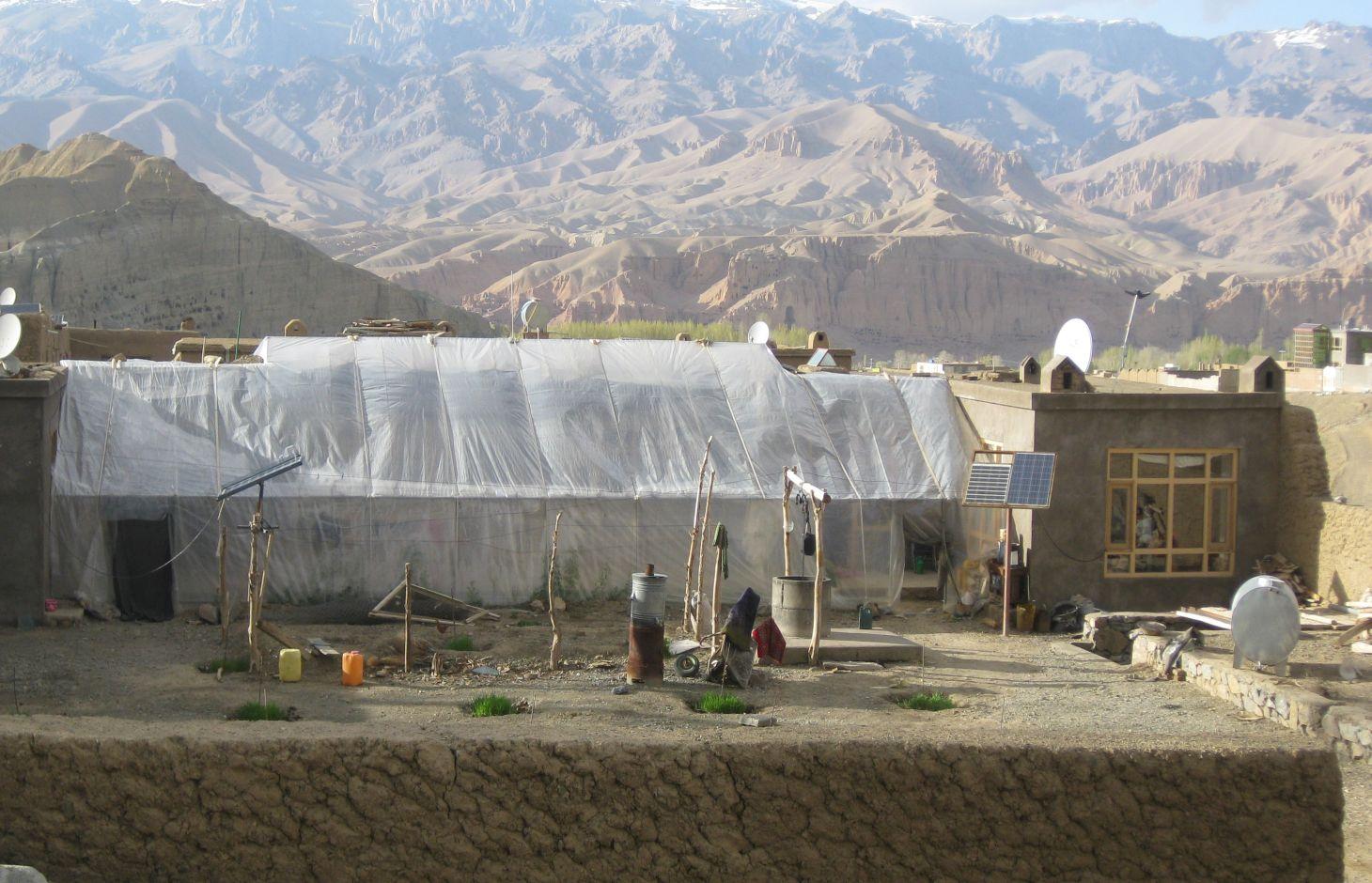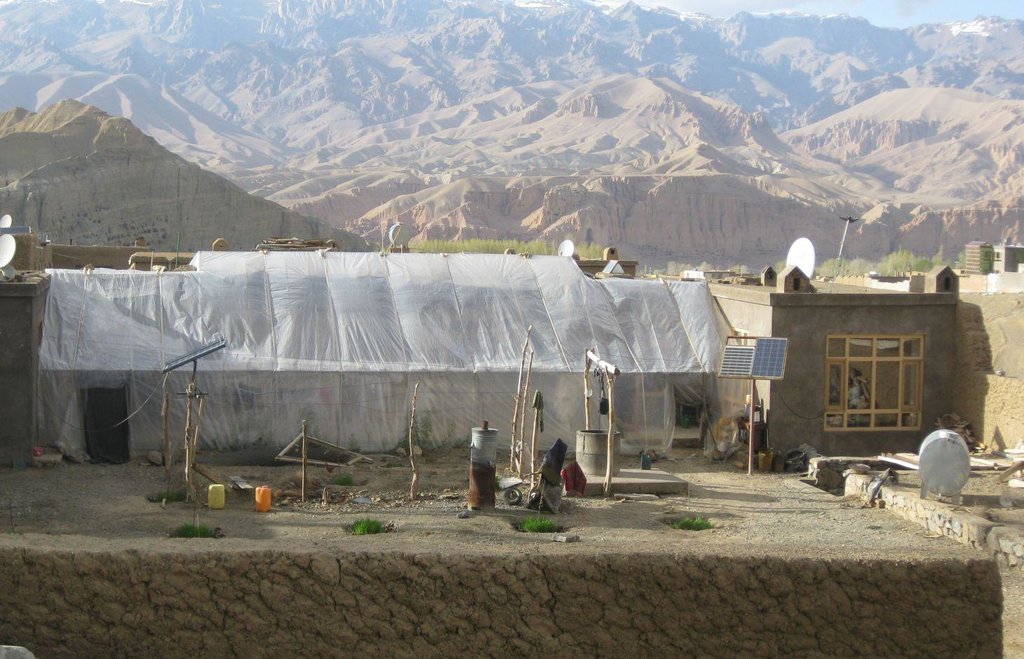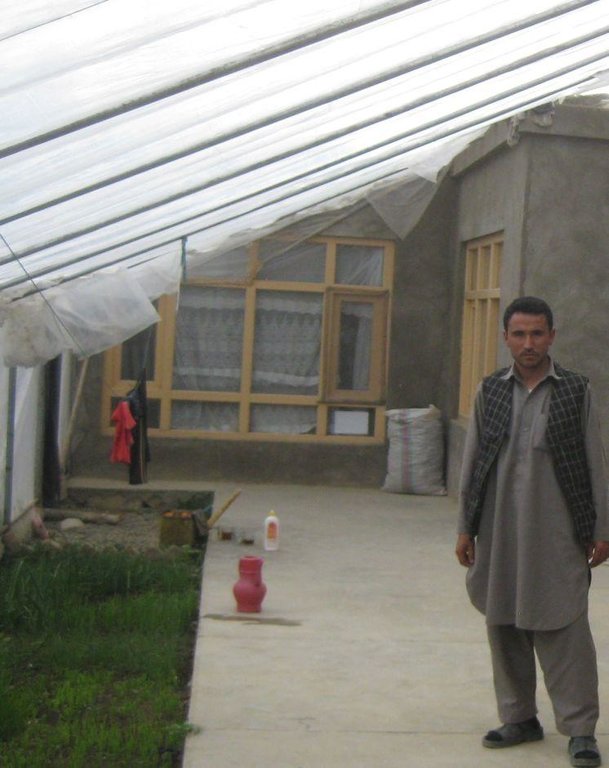Passive Solar House (PSH) [อัฟกานิสถาน]
- ผู้สร้างสรรค์:
- การอัพเดท:
- ผู้รวบรวม: Aqila Haidery
- ผู้เรียบเรียง: –
- ผู้ตรวจสอบ: Deborah Niggli
Garm Khana
technologies_1602 - อัฟกานิสถาน
ดูส่วนย่อย
ขยายทั้งหมด ย่อทั้งหมด1. ข้อมูลทั่วไป
1.2 รายละเอียดที่ติดต่อได้ของผู้รวบรวมและองค์กรที่เกี่ยวข้องในการประเมินและการจัดเตรียมทำเอกสารของเทคโนโลยี
ผู้เชี่ยวชาญ SLM:
ผู้เชี่ยวชาญ SLM:
ชื่อขององค์กรซึ่งอำนวยความสะดวกในการทำเอกสารหรือการประเมินเทคโนโลยี (ถ้าเกี่ยวข้อง)
HELVETAS (Swiss Intercooperation)1.3 เงื่อนไขการใช้ข้อมูลที่ได้บันทึกผ่านทาง WOCAT
วันที่เก็บรวบรวมข้อมูล(ภาคสนาม) :
12/05/2014
ผู้รวบรวมและวิทยากรหลักยอมรับเงื่อนไขเกี่ยวกับการใช้ข้อมูลที่ถูกบันทึกผ่านทาง WOCAT:
ใช่
1.4 การเปิดเผยเรื่องความยั่งยืนของเทคโนโลยีที่ได้อธิบายไว้
เทคโนโลยีที่ได้อธิบายไว้นี้เป็นปัญหาของความเสื่อมโทรมโทรมของที่ดินหรือไม่ จึงไม่ได้รับการยอมรับว่าเป็นเทคโนโลยีเพื่อการจัดการที่ดินอย่างยั่งยืน:
ไม่ใช่
2. การอธิบายลักษณะของเทคโนโลยี SLM
2.1 การอธิบายแบบสั้น ๆ ของเทคโนโลยี
คำจำกัดความของเทคโนโลยี:
A clean energy technology for converting solar energy into heat for warming homes.
2.2 การอธิบายแบบละเอียดของเทคโนโลยี
คำอธิบาย:
Passive Solar House technology is documented by Sustainable Land Management Project/HELVETAS Swiss Intercooperation with financial support of Swiss Agency for Development and Cooperation.
Households in Bayman Centre experience very cold winters and meeting household energy needs for the Bamyan population is challenging. They mostly rely on unsustainable solutions such as burning manure or mountain shrubs. Shrub harvesting for firewood is a major cause of land degradation in the province. Fuel expenses also deplete the financial resources of an already impoverished population. Also, due to the intense cold, very few activities are possible during the winter. To overcome the challenges of heavy dependence on biomass for winter heating and to improve living conditions, many families in Bamyan Centre are adopting the passive solar technology for improving their living conditions, while reducing pressure on environment.
Passive solar technology captures sunlight in a room or building, and converts that energy into low-temperate heat. It provides an efficient mean of capturing the sun's energy, reducing the need for fuel wood and coal for heating.
(1) The passive solar house (PSH) technology has significant economic, socio-cultural and environmental benefits. They are as follows:
(2) reducing the reliance on shrubs and other heating materials; saving expenditure on fuel (aprox.25,000 Afghani/year) and the time usually spent on harvesting bushes;
(3) provision of extra space in the house for washing/drying cloths, bathing, social activities, play and study area, space for vegetable crops for home consumption; savings due to this technology offset the high initial investment cost;
(4) improved health due to less exposure to cold;
(5) reduced pressure on environment. The technology contributes to re-greening of common lands or rangelands where fewer shrubs are collected (uprooted) for firewood.
PSH should have a Southern exposure to take maximum advantage of the sun for daylight and passive solar heating. Most of the houses in Bamyan have southern exposures. The PSH is generally used for 6 months (November to April).
Although the technology was introduced in Bamyan by GERES, an International Non-Governmental Organization, many families have replicated it without any external support.
The main purpose of Passive Solar House technology is to make use of the solar energy for heating homes. As a result, the need for shrubs and coal for home heating is reduced significantly. The technology contributes to re-greening of common lands or range lands on which shrubs are harvested (uprooted) for firewood. Barat Ali's family bought about 60 donkey loads of shrubs per year for winter heating purposes. They did not have to do that after this technology was implemented by the PSH owner. The technology also contributes to the well-being of all family members, especially of women, who can do their household chores, and children who often got sick due to cold exposure.
The PSH presented here was established in September 2013 before the onset of winter. A transparent plastic sheet, metal pipes, wires and ropes to hold the plastic are used for construction work. Metal pipes were purchased from Kabul by the owner.
The PSH measures 17 m in length, 5 m in width and about 4 m in height. However, the PSH may vary from one house to another. The factor to consider is that the PSH should have long area to capture maximum sunlight. The upper part is slopping (about 30% gradient) to drain the water and snow. Local semi-skilled labor and skilled mechanic for welding the pipes were employed for construction works.
Approximately 45,000 Afghani/790 USD was spent on the construction of this PSH. The owner made significant investment. He purchased the pipes and plastic contributing approximately 70% of the costs. Plastic sheets, which are available on the market in Bamyan, are not of very high quality and have to be replaced each year. If the used plastic sheet is not too damaged, it is placed on roofs to protect from snow water/rain seepage. Otherwise, it is simply thrown away, which is not an environment friendly practice.
According to the PSH owner, a possibility for improvement is to use good quality wooden frame instead of pipes so that the plastic sheet can be kept intact by nailing it to the wooden frame. Using wooden frames may also reduce the cost of the technology, making it more affordable for poor families. Provision for ventilation is an aspect which needs to be considered while constructing PSH.
Bamyan province is a remote province of Afghanistan with high poverty rate. It has a temperate and arid climate. During winter, temperatures can drop below minus 22 degrees. Summer temperature can reach up to 34 degrees in the month of July. The average annual rainfall in the area is about 230 mm and some years can be very dry.
90% of the population relies on subsistence agriculture for their livelihoods and off-farm activities are marginal.
2.3 รูปภาพของเทคโนโลยี
2.5 ประเทศภูมิภาค หรือสถานที่ตั้งที่เทคโนโลยีได้นำไปใช้และได้รับการครอบคลุมโดยการประเมินนี้
ประเทศ:
อัฟกานิสถาน
ภูมิภาค/รัฐ/จังหวัด:
Bamyan
ข้อมูลจำเพาะเพิ่มเติมของสถานที่ตั้ง :
Bamyan Center / Dashte Esakhan
2.6 วันที่การดำเนินการ
ถ้าไม่รู้ปีที่แน่นอน ให้ระบุวันที่โดยประมาณ:
- น้อยกว่า 10 ปี (ไม่นานนี้)
2.7 คำแนะนำของเทคโนโลยี
ให้ระบุว่าเทคโนโลยีถูกแนะนำเข้ามาอย่างไร:
- ทางโครงการหรือจากภายนอก
ความคิดเห็น (ประเภทของโครงการ เป็นต้น) :
The PSH owner saw the technology applied by others and replicated it without any external support. The technology has been promoted by GERES (an International NGO) in Bamyan.
3. การจัดประเภทของเทคโนโลยี SLM
3.1 วัตถุประสงค์หลักของเทคโนโลยี
- สร้างผลกระทบทางด้านสังคมที่เป็นประโยชน์
3.2 ประเภทของการใช้ที่ดินในปัจจุบันที่ได้นำเทคโนโลยีไปใช้

การตั้งถิ่นฐาน โครงสร้างพื้นฐาน
- พลังงาน ท่อส่งก๊าซธรรมชาติ สายส่งไฟฟ้า
แสดงความคิดเห็น:
Major land use problems (compiler’s opinion): Degradation of common lands due to shrub harvesting for firewood and overgrazing by sheep and goats.
Major land use problems (land users’ perception): Land degradation due to uprooting of shrubs required for domestic purpose like heating homes during winter and cooking.
Constraints of Infrastructure (House): Lack of alternative energy resources. Heavy dependence on biomass for burning.
3.3 ข้อมูลเพิ่มเติมเกี่ยวกับการใช้ที่ดิน
ระบุ:
Longest growing period in days: 180, Longest growing period from month to month: April-September
3.4 กลุ่ม SLM ที่ตรงกับเทคโนโลยีนี้
- ประสิทธิภาพด้านพลังงาน
3.5 กระจายตัวของเทคโนโลยี
ระบุการกระจายตัวของเทคโนโลยี:
- กระจายไปอย่างสม่ำเสมอในพื้นที่
ถ้าหากว่าเทคโนโลยีได้มีการกระจายออกไปอย่างสม่ำเสมอในพื้นที่ ให้ระบุปริมาณพื้นที่ที่ได้รับการครอบคลุมถึง:
- < 0.1 ตร.กม.(10 เฮกตาร์)
แสดงความคิดเห็น:
Total area covered by the SLM Technology is 0.00027 m2.
The PSH and house areas are 85 and 270 square meter, respectively.
3.6 มาตรการ SLM ที่ประกอบกันเป็นเทคโนโลยี

มาตรการอนุรักษ์ด้วยโครงสร้าง
- S11: อื่น ๆ
แสดงความคิดเห็น:
Specification of other structural measures: Passive Solar House
3.7 รูปแบบหลักของการเสื่อมโทรมของที่ดินที่ได้รับการแก้ไขโดยเทคโนโลยี

การเสื่อมโทรมของดินทางด้านชีวภาพ
- Bc (Reduction of vegetation cover): การลดลงของจำนวนพืชที่ปกคลุมดิน
แสดงความคิดเห็น:
Main causes of degradation: over-exploitation of vegetation for domestic use (Shrubs for fuel wood), overgrazing (Mainly sheep and goats), governance / institutional (Specially relating to common lands), lack of alternative energy options
Secondary causes of degradation: droughts, population pressure
3.8 การป้องกัน การลดลง หรือการฟื้นฟูความเสื่อมโทรมของที่ดิน
ระบุเป้าหมายของเทคโนโลยีกับความเสื่อมโทรมของที่ดิน:
- ป้องกันความเสื่อมโทรมของที่ดิน
- ลดความเสื่อมโทรมของดิน
4. ข้อมูลจำเพาะด้านเทคนิค กิจกรรมการนำไปปฏิบัติใช้ ปัจจัยนำเข้า และค่าใช้จ่าย
4.1 แบบแปลนทางเทคนิคของเทคโนโลยี
ผู้เขียน:
SLM Project, Helvetas, HELVETAS Swiss Intercooperation Afghanistan
4.2 ข้อมูลจำเพาะด้านเทคนิคและการอธิบายแบบแปลนทางเทคนิค
Technical specification of South facing Passive Solar House constructed by the house owner comprising white plastic sheet, pipes for framers, string tied outside to secure plastic. Entrance gates.
Location: Dashte Esakhan. Bamyan Centre
Date: 12.05.2014
Technical knowledge required for field staff / advisors: moderate
Technical knowledge required for land users: moderate
Main technical functions: improvement of ground cover
Structural measure: Passive Solar House
Height of bunds/banks/others (m): 4
Width of bunds/banks/others (m): 5
Length of bunds/banks/others (m): 17
Construction material (other): Plastic sheet, metal pipes, wires
4.3 ข้อมูลทั่วไปเกี่ยวกับการคำนวณปัจจัยนำเข้าและค่าใช้จ่าย
อื่นๆ หรือสกุลเงินประจำชาติ (ระบุ):
Afghani
ระบุอัตราแลกเปลี่ยนจากดอลลาร์สหรัฐเป็นสกุลเงินท้องถิ่น (ถ้าเกี่ยวข้อง) คือ 1 เหรียญสหรัฐ =:
57.0
4.4 กิจกรรมเพื่อการจัดตั้ง
| กิจกรรม | ประเภทของมาตรการ | ช่วงเวลาดำเนินการ | |
|---|---|---|---|
| 1. | Purchase material from Kabul | ด้วยโครงสร้าง | September 2013 |
| 2. | Construction of PSH using 4 semi-skilled workers for 3 days and one skilled mechanic | ด้วยโครงสร้าง | September 2013 |
4.5 ค่าใช้จ่ายของปัจจัยนำเข้าที่จำเป็นสำหรับการจัดตั้ง
| ปัจจัยนำเข้า | หน่วย | ปริมาณ | ค่าใช้จ่ายต่อหน่วย | ค่าใช้จ่ายทั้งหมดต่อปัจจัยนำเข้า | %ของค่าใช้จ่ายที่ก่อให้เกิดขึ้นโดยผู้ใช้ที่ดิน | |
|---|---|---|---|---|---|---|
| แรงงาน | labour | ha | 1.0 | 190.12 | 190.12 | 100.0 |
| อุปกรณ์ | plastic | ha | 1.0 | 70.28 | 70.28 | 100.0 |
| อุปกรณ์ | pipes | ha | 1.0 | 530.31 | 530.31 | 100.0 |
| ค่าใช้จ่ายทั้งหมดของการจัดตั้งเทคโนโลยี | 790.71 | |||||
แสดงความคิดเห็น:
Duration of establishment phase: 1 month(s)
4.6 การบำรุงรักษาสภาพหรือกิจกรรมที่เกิดขึ้นเป็นประจำ
| กิจกรรม | ประเภทของมาตรการ | ช่วงระยะเวลา/ความถี่ | |
|---|---|---|---|
| 1. | Maintainance - plastic sheet | ด้วยโครงสร้าง | As required |
| 2. | Replacement of plastic sheet every year | ด้วยโครงสร้าง |
4.7 ค่าใช้จ่ายของปัจจัยนำเข้าและกิจกรรมที่เกิดขึ้นเป็นประจำที่ต้องการการบำรุงรักษา (ต่อปี)
| ปัจจัยนำเข้า | หน่วย | ปริมาณ | ค่าใช้จ่ายต่อหน่วย | ค่าใช้จ่ายทั้งหมดต่อปัจจัยนำเข้า | %ของค่าใช้จ่ายที่ก่อให้เกิดขึ้นโดยผู้ใช้ที่ดิน | |
|---|---|---|---|---|---|---|
| แรงงาน | labour | ha | 1.0 | 13.78 | 13.78 | 100.0 |
| อุปกรณ์ | plastic | ha | 1.0 | 68.92 | 68.92 | 100.0 |
| ค่าใช้จ่ายทั้งหมดของการบำรุงรักษาสภาพเทคโนโลยี | 82.7 | |||||
แสดงความคิดเห็น:
Machinery/ tools: Plastic Sheets, Pipes, Wires, Generator, Welding Machine
The prices in Afghani are for September 2013. The exchange rate which was used for the conversion of US$ to Afghani was 1 US$ = 57 Afghani.
4.8 ปัจจัยสำคัญที่สุดที่มีผลกระทบต่อค่าใช้จ่าย
ปัจจัยสำคัญที่สุดที่มีผลกระทบต่อค่าใช้จ่ายต่างๆ:
Pipes is the most expensive part of this technology
5. สิ่งแวดล้อมทางธรรมชาติและของมนุษย์
5.1 ภูมิอากาศ
ฝนประจำปี
- < 250 ม.ม.
- 251-500 ม.ม.
- 501-750 ม.ม.
- 751-1,000 ม.ม.
- 1,001-1,500 ม.ม.
- 1,501-2,000 ม.ม.
- 2,001-3,000 ม.ม.
- 3,001-4,000 ม.ม.
- > 4,000 ม.ม.
ข้อมูลจำเพาะ/ความคิดเห็นเรื่องปริมาณน้ำฝน:
Most rainfall in spring (April and May) and also there is snow.
เขตภูมิอากาศเกษตร
- กึ่งแห้งแล้ง
Thermal climate class: temperate. Bamyan has cold winter (temperatures can fall up to -22 degree C) and temperate summer.
5.2 สภาพภูมิประเทศ
ค่าเฉลี่ยความลาดชัน:
- ราบเรียบ (0-2%)
- ลาดที่ไม่ชัน (3-5%)
- ปานกลาง (6-10%)
- เป็นลูกคลื่น (11-15%)
- เป็นเนิน (16-30%)
- ชัน (31-60%)
- ชันมาก (>60%)
ธรณีสัณฐาน:
- ที่ราบสูง/ที่ราบ
- สันเขา
- ไหล่เขา
- ไหล่เนินเขา
- ตีนเนิน
- หุบเขา
ระดับความสูง:
- 0-100 เมตร
- 101-500 เมตร
- 501-1,000 เมตร
- 1,001-1,500 เมตร
- 1,501-2,000 เมตร
- 2,001-2,500 เมตร
- 2,501-3,000 เมตร
- 3,001-4,000 เมตร
- > 4,000 เมตร
5.3 ดิน
ค่าเฉลี่ยความลึกของดิน:
- ตื้นมาก (0-20 ซ.ม.)
- ตื้น (21-50 ซ.ม.)
- ลึกปานกลาง (51-80 ซ.ม.)
- ลึก (81-120 ซ.ม.)
- ลึกมาก (>120 ซ.ม.)
เนื้อดิน (ดินชั้นบน):
- หยาบ/เบา (ดินทราย)
อินทรียวัตถุในดิน:
- ปานกลาง (1-3%)
5.4 ความเป็นประโยชน์และคุณภาพของน้ำ
ระดับน้ำใต้ดิน:
5-50 เมตร
น้ำไหลบ่าที่ผิวดิน:
ไม่ดีหรือไม่มีเลย
คุณภาพน้ำ (ที่ยังไม่ได้บำบัด):
เป็นน้ำเพื่อการดื่มที่ดี
5.5 ความหลากหลายทางชีวภาพ
ความหลากหลายทางชนิดพันธุ์:
- ต่ำ
5.6 ลักษณะของผู้ใช้ที่ดินที่นำเทคโนโลยีไปปฏิบัติใช้
รายได้ที่มาจากนอกฟาร์ม:
- 10-50% ของรายได้ทั้งหมด
ระดับของความมั่งคั่งโดยเปรียบเทียบ:
- พอมีพอกิน
เป็นรายบุคคล/ครัวเรือน:
- เป็นรายบุคคล/ครัวเรือน
เพศ:
- หญิง
- ชาย
ระบุลักษณะอื่นๆที่เกี่ยวข้องของผู้ใช้ที่ดิน:
Land users applying the Technology are mainly common / average land users
Difference in the involvement of women and men: All the PSH construction work is done by men.
Population density: 10-50 persons/km2
Annual population growth: 2% - 3%
100% of the land users are average wealthy.
5.7 พื้นที่เฉลี่ยของที่ดินที่เป็นเจ้าของหรือเช่าโดยผู้ใช้ที่ดินที่นำเทคโนโลยีไปปฏิบัติใช้
- < 0.5 เฮกตาร์
- 0.5-1 เฮกตาร์
- 1-2 เฮกตาร์
- 2-5 เฮกตาร์
- 5-15 เฮกตาร์
- 15-50 เฮกตาร์
- 50-100 เฮกตาร์
- 100-500 เฮกตาร์
- 500-1,000 เฮกตาร์
- 1,000-10,000 เฮกตาร์
- >10,000 เฮกตาร์
พิจารณาว่าเป็นขนาดเล็ก กลาง หรือขนาดใหญ่ (ซึ่งอ้างอิงถึงบริบทระดับท้องถิ่น):
- ขนาดเล็ก
5.8 กรรมสิทธิ์ในที่ดิน สิทธิในการใช้ที่ดินและสิทธิในการใช้น้ำ
กรรมสิทธิ์ในที่ดิน:
- รายบุคคล ได้รับสิทธิครอบครอง
สิทธิในการใช้ที่ดิน:
- รายบุคคล
สิทธิในการใช้น้ำ:
- รายบุคคล
แสดงความคิดเห็น:
Well belongs to the house owner
5.9 การเข้าถึงบริการและโครงสร้างพื้นฐาน
สุขภาพ:
- จน
- ปานกลาง
- ดี
การศึกษา:
- จน
- ปานกลาง
- ดี
ความช่วยเหลือทางด้านเทคนิค:
- จน
- ปานกลาง
- ดี
การจ้างงาน (เช่น ภายนอกฟาร์ม):
- จน
- ปานกลาง
- ดี
ตลาด:
- จน
- ปานกลาง
- ดี
พลังงาน:
- จน
- ปานกลาง
- ดี
ถนนและการขนส่ง:
- จน
- ปานกลาง
- ดี
น้ำดื่มและการสุขาภิบาล:
- จน
- ปานกลาง
- ดี
บริการด้านการเงิน:
- จน
- ปานกลาง
- ดี
6. ผลกระทบและสรุปคำบอกกล่าว
6.1 ผลกระทบในพื้นที่ดำเนินการ (On-site) จากการใช้เทคโนโลยี
ผลกระทบทางด้านเศรษฐกิจและสังคม
การผลิต
การผลิตพลังงาน
แสดงความคิดเห็น/ระบุ:
For winter season
รายได้และค่าใช้จ่าย
ภาระงาน
แสดงความคิดเห็น/ระบุ:
Time saved in shrubs collection, burning Bukharis stoves for house warming, going out for daily chores like drying clothes, etc.,
ผลกระทบทางด้านเศรษฐกิจและสังคมอื่น ๆ
Reduced expense on fuel (wood and coal)
แสดงความคิดเห็น/ระบุ:
Due to less consumption of coal and shrubs
Off-season vegetable production for self consumption
แสดงความคิดเห็น/ระบุ:
Harvested 5 times during winter/spring
Energy saving (coal bags)
แสดงความคิดเห็น/ระบุ:
Less use of coal for winter heating
ผลกระทบด้านสังคมวัฒนธรรมอื่น ๆ
ความมั่นคงด้านอาหาร / พึ่งตนเองได้
แสดงความคิดเห็น/ระบุ:
Due to increased fresh winter vegetable production. Cash saved can be used for buying food items.
สถานการณ์ด้านสุขภาพ
แสดงความคิดเห็น/ระบุ:
Women, men and children are less exposed to severe cold. Also consumption of vegetables grown in the PSH contributes to food diversity and health. PSH also protects chimney smoke from outside entering the house.
โอกาสทางวัฒนธรรม
แสดงความคิดเห็น/ระบุ:
PSH used for social meeting, children play and studies, washing/drying clothes, bathing etc.
SLM หรือความรู้เรื่องความเสื่อมโทรมของที่ดิน
แสดงความคิดเห็น/ระบุ:
In terms of reducing shrub cutting through alternative energy options. Others see and learn.
การบรรเทาความขัดแย้ง
contribution to human well-being
แสดงความคิดเห็น/ระบุ:
The technology has contributed to less expenditure on fuel, improved health and has created socio-cultural opportunities.
ผลกระทบด้านนิเวศวิทยา
วัฐจักรน้ำหรือน้ำบ่า
น้ำไหลบ่าที่ผิวดิน
แสดงความคิดเห็น/ระบุ:
As PSH has sloping top without any proper outlet for concentrated runoff
ความหลากหลายทางชีวภาพของพืชและสัตว์
ความหลากหลายทางชีวภาพของพืช
แสดงความคิดเห็น/ระบุ:
As the family can grow certain vegetable crops and flowers inside the PSH during winter time.
ลดความเสี่ยงของภัยพิบัติ
การปล่อยคาร์บอนและก๊าซเรือนกระจก
แสดงความคิดเห็น/ระบุ:
Because of less burning of coal and shrubs
6.2 ผลกระทบนอกพื้นที่ดำเนินการ (Off-site) จากการใช้เทคโนโลยี
Increased vagetation cover
แสดงความคิดเห็น/ระบุ:
Due to less extraction of shrubs for firewood for winter heating
Reduced soil erosion
แสดงความคิดเห็น/ระบุ:
Estimated
6.3 การเผชิญและความตอบสนองของเทคโนโลยีต่อการเปลี่ยนแปลงสภาพภูมิอากาศที่ค่อยเป็นค่อยไป และสภาพรุนแรงของภูมิอากาศ / ภัยพิบัติ (ที่รับรู้ได้โดยผู้ใช้ที่ดิน)
สภาพรุนแรงของภูมิอากาศ (ภัยพิบัติ)
ภัยพิบัติทางอุตุนิยมวิทยา
| เทคโนโลยีมีวิธีการรับมืออย่างไร | |
|---|---|
| พายุลมประจำท้องถิ่น | ไม่ค่อยดี |
ผลลัพธ์ตามมาที่เกี่ยวข้องกับภูมิอากาศอื่น ๆ
ผลลัพธ์ตามมาที่เกี่ยวข้องกับภูมิอากาศอื่น ๆ
| เทคโนโลยีมีวิธีการรับมืออย่างไร | |
|---|---|
| Intense sun light | ไม่ค่อยดี |
แสดงความคิดเห็น:
Pipes should be replaced by wooden frames because they get heated up and can damage the plastic. Also, using wooden frames may reduce the cost.
6.4 การวิเคราะห์ค่าใช้จ่ายและผลประโยชน์ที่ได้รับ
ผลประโยชน์ที่ได้รับเปรียบเทียบกับค่าใช้จ่ายในการจัดตั้งเป็นอย่างไร (จากมุมมองของผู้ใช้ที่ดิน)
ผลตอบแทนระยะสั้น:
เป็นกลางหรือสมดุล
ผลตอบแทนระยะยาว:
ด้านบวกอย่างมาก
ผลประโยชน์ที่ได้รับเปรียบเทียบกับค่าใช้จ่ายในการบำรุงรักษาหรือต้นทุนที่เกิดขึ้นซ้ำอีก เป็นอย่างไร (จากมุมมองของผู้ใช้ที่ดิน)
ผลตอบแทนระยะสั้น:
ด้านบวก
ผลตอบแทนระยะยาว:
ด้านบวกอย่างมาก
แสดงความคิดเห็น:
The cost of the PSH can be covered in 2 years time. This is only in financial terms but if we analyse the overall economic benefits considering health and ecological benefits, the benefits compared with establishment costs will be more.
6.5 การปรับตัวของเทคโนโลยี
จากทั้งหมดที่ได้รับเทคโนโลยีเข้ามามีจำนวนเท่าใดที่ทำแบบทันที โดยไม่ได้รับการจูงใจด้านวัสดุหรือการเงินใด ๆ:
- 90-100%
แสดงความคิดเห็น:
100% of land user families have adopted the Technology without any external material support
30 land user families have adopted the Technology without any external material support
There is a moderate trend towards spontaneous adoption of the Technology
6.7 จุดแข็ง / ข้อได้เปรียบ / โอกาสของเทคโนโลยี
| จุดแข็ง / ข้อได้เปรียบ / โอกาสในทัศนคติของผู้ใช้ที่ดิน |
|---|
| Multiple benefits for the family - less expense for fuel, children can play inside in warm climate. It is also a good space for social meetings. |
| จุดแข็ง / ข้อได้เปรียบ / โอกาสในทัศนคติของผู้รวบรวมหรือวิทยากรหลัก |
|---|
| PSH has multiple benefits: house warming using clean energy, less expenditure on fuel for winter, extra room for various activities (like studies, playing, washing, drying clothes, warming water, social meetings), less use of shrubs. |
| Due to PSH technology, families dependency on shrubs for firewood is reduced which leads to improved land management. |
| Convinced by the benefits of PSH technology, many families with financial resources have constructed it without seeking external support. |
6.8 จุดอ่อน / ข้อเสียเปรียบ / ความเสี่ยงของเทคโนโลยีและวิธีการแก้ไข
| จุดอ่อน / ข้อเสียเปรียบ / ความเสี่ยงในทัศนคติของผู้ใช้ที่ดิน | มีวิธีการแก้ไขได้อย่างไร |
|---|---|
| Metal pipe is not good for frame because the plastic sheet cannot be nailed to it so that it does not get blown away by wind. | Use of wooden frame. |
| Distance between pipes is more. | More pipes needed to reduce that gap. |
| The air moisture can increase in the PSH as well as in the other parts of the house. | The door and if possible the window of the PSH should be opened for some minutes during the day. |
| จุดอ่อน / ข้อเสียเปรียบ / ความเสี่ยงในทัศนคติของผู้รวบรวมหรือวิทยากรหลัก | มีวิธีการแก้ไขได้อย่างไร |
|---|---|
| PSH does not have proper ventilation. | Construction of a ventilator. |
| The poor households cannot apply it due to high establishment cost. | Use of low cost wooden frame and some incentives to the poor families for establishment. |
7. การอ้างอิงและการเชื่อมต่อ
7.1 วิธีการและแหล่งข้อมูล
- ไปเยี่ยมชมภาคสนาม การสำรวจพื้นที่ภาคสนาม
- การสัมภาษณ์กับผู้ใช้ที่ดิน
ลิงก์และโมดูล
ขยายทั้งหมด ย่อทั้งหมดลิงก์
ไม่มีลิงก์
โมดูล
ไม่มีโมดูล




